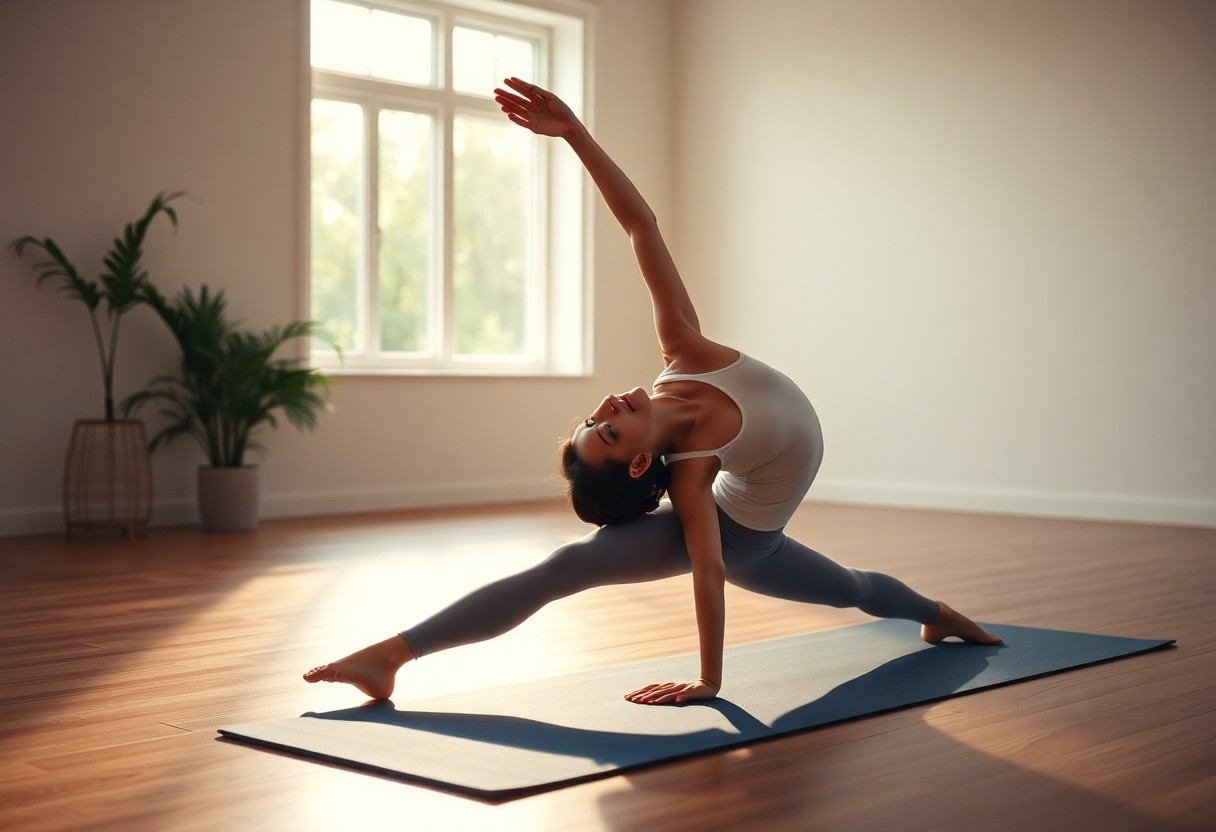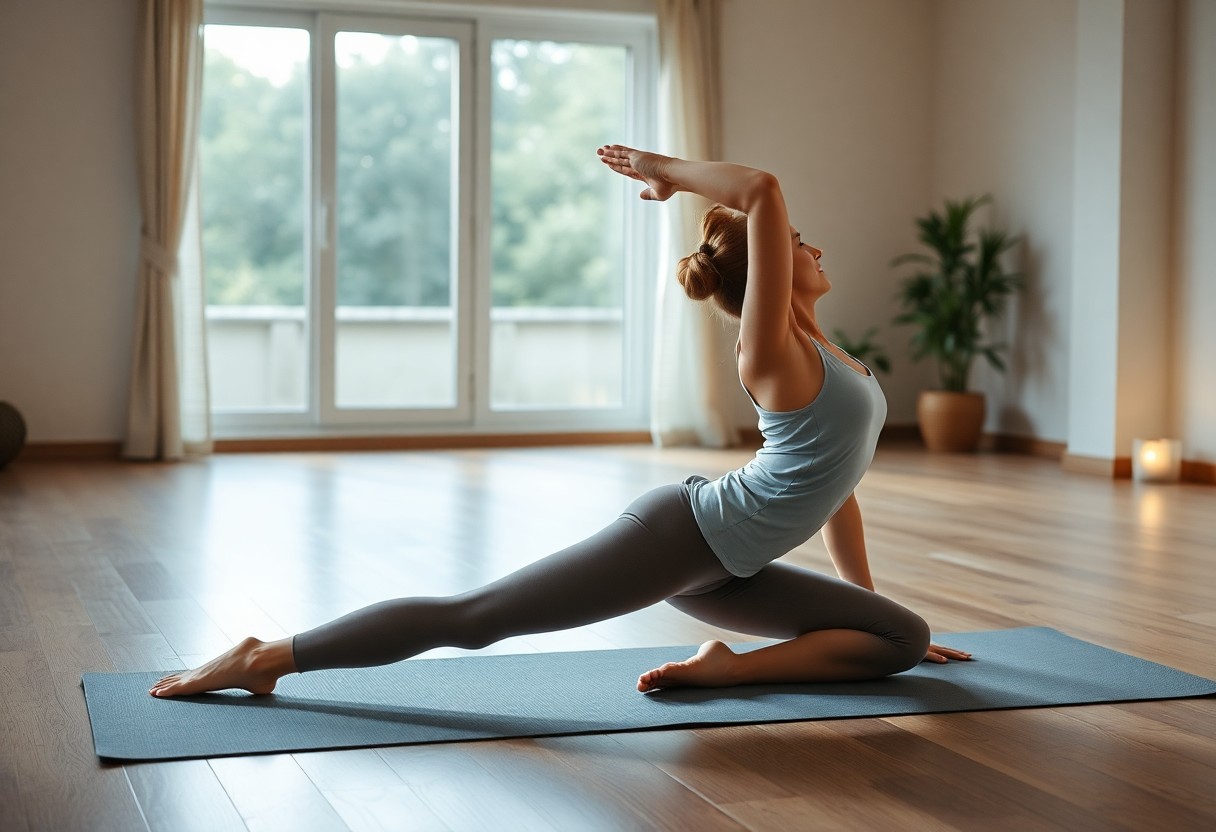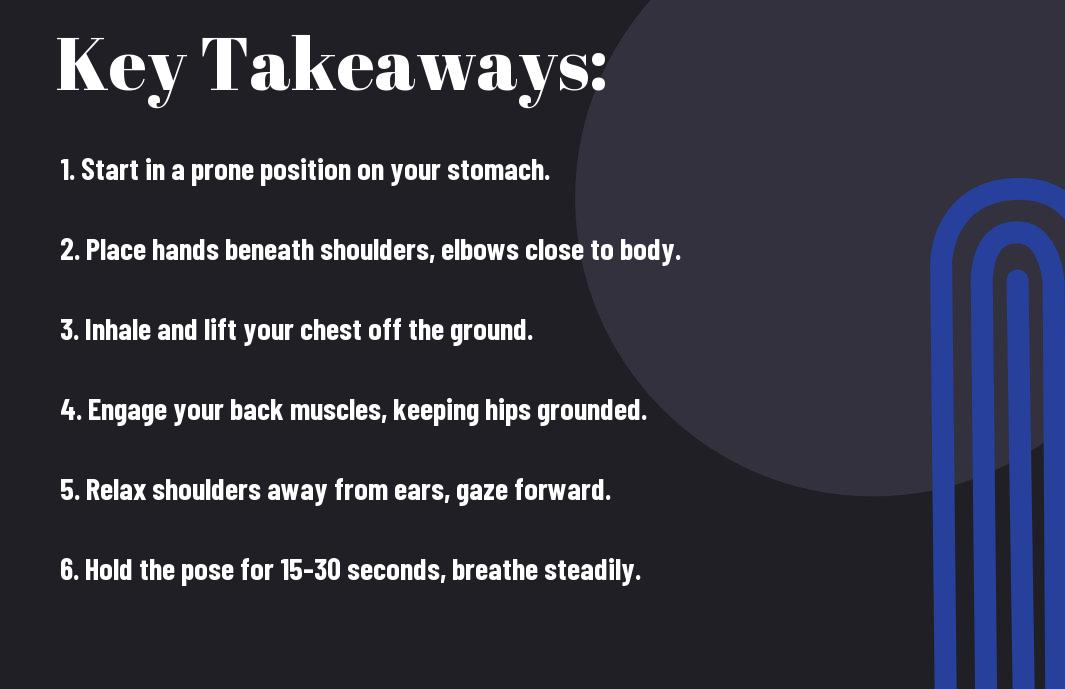It's crucial to understand the benefits and technique of the Cobra Pose, a foundational yoga posture that promotes flexibility, strengthens your spine, and opens up your chest. In this step-by-step guide, you will learn how to properly perform Cobra Pose, ensuring that you maintain correct alignment and avoid injury. This guide is designed with beginners in mind, providing you with clear instructions and helpful tips to enhance your yoga practice and overall well-being. Let's explore the steps to master this invigorating pose!
Understanding Cobra Pose
For those new to yoga, the Cobra Pose, or Bhujangasana, is a foundational backbend that promotes spinal flexibility and strength. This pose mimics the raised hood of a cobra, allowing you to engage your chest and open your heart. By practicing Cobra Pose, you enhance your body's awareness and cultivate necessary skills for more advanced postures, making it a perfect addition to your yoga routine.
Benefits of Cobra Pose
To reap the numerous benefits of Cobra Pose, you'll find it strengthens your spine, improves posture, and stretches vital areas such as the chest and shoulders. This pose energizes your body and can alleviate tension in the lower back, making it ideal for counteracting the effects of prolonged sitting. Additionally, it can stimulate digestive organs and enhance overall vitality.
Common Misalignments
Above all, maintaining proper alignment during Cobra Pose is necessary for maximizing its benefits and safeguarding against injury. You may find yourself occasionally overextending your lower back or collapsing your shoulders, which can lead to discomfort or strain.
The most common misalignments in Cobra Pose include an overly arched lower back, where you're pressing your pelvis into the floor too firmly, and allowing your shoulders to creep up toward your ears. Ensure that your elbows remain close to your body and that you engage your core to support your lower back. By focusing on aligning your spine and keeping your shoulders relaxed, you'll cultivate a more effective and safe practice.

Preparing for Cobra Pose
It is imperative to prepare your body for Cobra Pose to ensure proper alignment and avoid strain. Begin by creating a calm environment and focusing on your breath. Ensure you wear comfortable clothing that allows for easy movement, and consider practicing on a yoga mat for added support. Engaging in a thoughtful preparation routine will set the stage for a more effective and enjoyable experience in the Cobra Pose.
Essential Warm-Up Stretches
Warm-up exercises like Cat-Cow stretches and gentle side bends will help to open your spine and warm up your core muscles. Including these stretches in your routine allows for better flexibility and gradual easing into the backbending motion of Cobra Pose, enhancing your overall practice.
Tools and Props
After establishing a warm-up routine, you may benefit from using props to support your practice and enhance your comfort.
Understanding the right tools can make your experience in Cobra Pose more effective. Yoga blocks can help elevate your hands for added support if you struggle to lift your torso. A folded blanket under your pelvis can provide cushioning and alleviate any discomfort. These props not only give you stability but also encourage proper alignment, allowing you to focus on your breath and the pose’s benefits without distraction. Investing in useful tools elevates your yoga practice to a new level of comfort and awareness.
Step-by-Step Guide
One of the best ways to master the Cobra Pose is by following a clear step-by-step approach. For those who feel challenged, check out this thread about people who can barely go up in cobra pose? : r/yoga. Below is a detailed guide to help you on your yoga journey.
Step-by-Step Instructions
| 1. Lie flat on your stomach | Ensure your legs are extended and feet are hip-width apart. |
| 2. Place your hands under your shoulders | Align your elbows close to your body. |
| 3. Press into your hands | Slowly lift your chest while keeping your pelvis on the ground. |
| 4. Hold the pose | Breathe deeply while keeping your shoulders relaxed. |
Getting into Position
To effectively enter Cobra Pose, begin by lying flat on your stomach with your forehead resting on the mat. Position your legs parallel to each other, allowing your feet to be hip-width apart. Place your hands under your shoulders and keep your elbows bent close to your body, ready to help you lift your upper body.
Maintaining Proper Form
On lifting your chest, ensure that your shoulders are relaxed and away from your ears. Focus on elongating your spine while pressing your pelvis into the mat. Keep your elbows soft and your gaze slightly upward, creating a gentle stretch through your chest and abdomen.
Into maintaining proper form, engage your core muscles for additional support, and avoid excessive arching in your lower back. This will help you keep your body aligned, allowing for a balanced and stable posture. Continuously check your body position throughout the pose, ensuring that you're neither overextending nor straining, which will enhance your experience and effectiveness in practicing Cobra Pose.
Modifications for Beginners
Once again, as a beginner, you can modify Cobra Pose to suit your level of flexibility and strength. If full Cobra is too intense, try practicing with your elbows bent and resting on the ground instead of extending your arms fully. This will help you engage your back muscles without overexerting yourself. You can also keep your legs closer together or even place a cushion under your hips for added support, allowing you to ease into the pose gradually.
Gentle Variations
Beside modified versions of Cobra, consider incorporating gentle variations that can promote comfort and accessibility. For instance, try the Sphinx Pose, where you keep your forearms on the ground and your chest lifted. This variation provides a similar backbend without excessive strain, making it perfect for building strength over time as you prepare for full Cobra Pose.
Avoiding Strain
Between achieving the benefits of Cobra Pose and ensuring your safety, it's important to focus on avoiding strain. Pay attention to your body's signals and listen to what it needs. If you experience any discomfort in your lower back, opt for a lower height in your backbend or even skip the pose entirely until you build more strength and flexibility.
Further, to avoid strain in your lower back, engage your core muscles while performing Cobra Pose. This will support your spine and help prevent overextension. Additionally, keep your shoulders away from your ears and do not hyperextend your neck. Focus on lengthening your spine instead of pushing your chest too high. Modifying your approach and honed awareness will help you enjoy this pose safely and effectively as you progress in your practice.
Incorporating Cobra Pose into Your Routine
Now that you understand the basics of Cobra Pose, it's time to include it in your regular routine. This pose can be practiced daily or several times a week to enhance flexibility and strengthen your back. For detailed instructions, check out this guide on How to Do a Cobra Yoga Pose. Integrating Cobra Pose into your sessions will help you reap its benefits effectively.
Recommended Frequency
Your practice can start with two to three times a week, gradually increasing as you become more comfortable and confident in the pose. Aim for about five breaths in Cobra Pose during each session for optimal results.
Pairing with Other Poses
A great way to enhance your yoga practice is to pair Cobra Pose with other complementary poses. Incorporating poses like Downward Dog and Child's Pose will create a well-rounded routine that promotes flexibility and strength.
As you progress, consider incorporating restorative poses such as Savasana and gentle twists to provide balance to the energizing effects of Cobra Pose. This combination not only aids in deepening your practice but also helps in alleviating tension and promoting relaxation throughout your body.

Troubleshooting Common Issues
Your practice of Cobra Pose may sometimes come with challenges. It's imperative to recognize and address common issues to enhance your experience. From discomfort to difficulty in alignment, understanding how to troubleshoot these problems can help you perform the pose safely and effectively. Don't hesitate to make adjustments, as this can significantly improve your practice.
Pain and Discomfort
About experiencing pain or discomfort during Cobra Pose, it's important to listen to your body. If you feel strain in your lower back or shoulders, you may be overextending or misaligning your posture. Focus on keeping your elbows bent and your shoulders relaxed, ensuring a gentle lift from your chest without compromising your alignment.
Adjusting the Practice
About adjusting your practice, be open to modifying your stance or incorporating props, like a towel or block, for support. If you struggle with your lower back, elevating your hands on a block can alleviate strain, allowing you to engage your core while maintaining proper form. Small tweaks can lead to a more enjoyable experience.
Discomfort during Cobra Pose can sometimes stem from misalignment or lack of flexibility. Focus on engaging your core to stabilize your spine, rather than relying solely on your lower back for support. Additionally, you can lower your head or adjust the height of your hands to find a position that feels more comfortable. Always prioritize your body’s signals and make modifications as needed to ensure a safe practice.

Summing up
Summing up, the Cobra Pose is a fundamental yoga asana that can greatly enhance your flexibility and strengthen your back. By following this step-by-step guide, you can master the pose safely and effectively. Ensuring proper alignment and breathing during your practice will help you reap the most benefits. As you incorporate Cobra Pose into your routine, you'll notice improvements in your posture and overall well-being. Embrace the journey and allow your body to adapt and grow stronger with each practice.
Q: What is Cobra Pose and what are its benefits?
A: Cobra Pose, or Bhujangasana, is a beginner-friendly yoga posture that primarily stretches the spine and strengthens the back muscles. Benefits include improved flexibility in the spine, relief from lower back pain, better posture, and stimulation of abdominal organs, which aids in digestion. Additionally, it can help alleviate stress and fatigue, making it a great addition to your daily routine.
Q: How do I properly set up for Cobra Pose?
A: To correctly set up for Cobra Pose, start by lying face down on your yoga mat. Ensure your legs are straight and your feet are hip-width apart, with the tops of your feet pressing against the mat. Place your hands underneath your shoulders, keeping your elbows close to your body. This setup helps create a foundation for lifting your torso while maintaining proper alignment.
Q: What are the steps for performing Cobra Pose?
A: To perform Cobra Pose, follow these steps: 1. Begin by lying face down with your legs straight and feet hip-width apart. 2. Place your palms under your shoulders, elbows bent and close to your sides. 3. Inhale deeply and gently lift your chest off the mat, using the strength of your back rather than pushing through your hands. 4. Keep your shoulders relaxed and away from your ears, and draw your shoulder blades back. 5. Hold the pose for 15 to 30 seconds, breathing deeply, before slowly lowering back down to the mat on an exhale. Repeat as desired, ensuring you maintain comfort and awareness of your body's limits.
Q: Are there any precautions I should take while practicing Cobra Pose?
A: Yes, there are a few precautions to consider. If you have a recent injury to your back or wrists, or if you experience chronic pain in these areas, consult a healthcare professional before attempting Cobra Pose. Pregnant individuals should avoid this pose in the later stages of pregnancy. It's important to listen to your body and prevent any overstretching or discomfort that might arise during practice.
Q: How can I modify Cobra Pose to better suit my level of experience?
A: If you're new to Cobra Pose or find it challenging, you can modify it by keeping your elbows bent and your forearms on the mat, entering a version called Sphinx Pose. This position reduces the intensity of the lower back arch and provides support while still gaining the benefits of the pose. Additionally, you can lower the height of the lift by only raising your chest a few inches off the ground until you build strength and comfort.

0 Comments